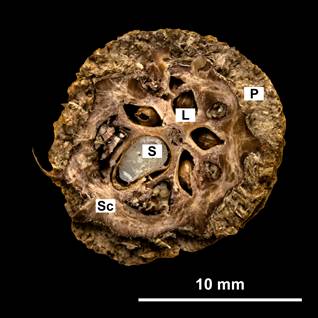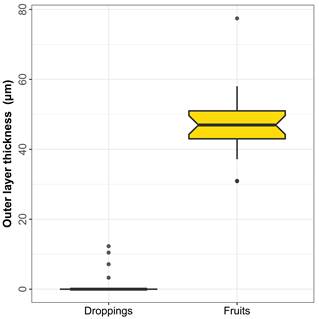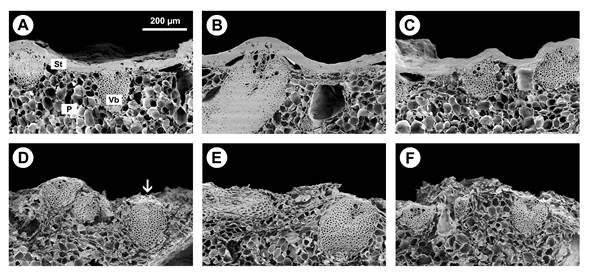Introduction
Frugivory is one of the principal processes in the natural regeneration of numerous plant populations, given that this is mostly sustained by animal-mediated seed dispersal (Jordano, 2000). Seed dispersers play a key role in ecology and evolution of fleshy-fruited plants, especially in tropical environments, where it is estimated that between 70% and 90% of all woody species are dispersed by vertebrates (Fleming et al., 1987; Jordano, 2000). In this animal-plant interaction, animals obtain nutrients from fruit consumption, whereas plants are able to disperse their seeds far from the parent plant. Moreover, they can obtain other benefits from the treatment the seeds undergo in the disperser’s digestive tract, such as pulp removal (seed cleaning), outer layer scarification, and/or fertilization effects by nutrients in the fecal matter in which seeds are embedded (Dennis, 2007; Traveset et al., 2007; Schupp et al. 2010).
Some vertebrate groups, owing to their anatomical, physiological and behavioral traits, can be important seed dispersers in tropical environments (Chapman and Russo, 2006). Primates, for instance, ingest a wide variety of fruits and defecate or spit out numerous seeds (Lambert, 1999). As a consequence, their great value for maintaining vegetal structure and composition of the ecosystems they inhabit has been acknowledged (Duncan and Chapman, 1999; Chapman and Russo, 2006; Link and Di Fiore, 2006; Stevenson, 2011). Howler monkeys (Alouatta spp.) are a genus of primates distributed in tropical areas from the northwest of Argentina to the south of Mexico. They are considered effective dispersers since many of the seeds they ingest remain viable after passing through their digestive tract (Arroyo-Rodríguez et al., 2015). In addition, because of their body size (≥4 kg), they are able to transport large seeds (≥10 mm) (Andresen, 2002). Dispersal services provided by these primates might be particularly relevant for some plant species with voluminous seeds (Anzures-Dadda et al., 2011), especially in heavily defaunated environments where many primary dispersers are no longer present (Gardner et al., 2019). The mantled howler monkey (Alouatta palliata mexicana Merriam, 1902), an endangered primate species, has its northern distribution limit on the American continent in the Los Tuxtlas region, Veracruz state, Mexico, where it feeds on the fruits of at least 51 plant species (22 families, 33 genera) (Estrada and Coates-Estrada, 1984; Serio-Silva et al., 2002; Asensio et al., 2007), therefore being a potential disperser of their seeds.
The yellow mombin (Spondias mombin L.) is one of the three species from the family Anacardiaceae whose fruits are ingested by mantled howler monkeys in the region of Los Tuxtlas (Dáttilo et al., 2014). During the fructification period (July-October) these fruits constitute a significant source of lipids, proteins, minerals, fiber, and mostly carbohydrates and energy (Kcal) (Serio-Silva et al., 2002; Vázquez-Torres et al., 2010; Hauck-Tiburski et al., 2011). This tree is native from the south of Mexico to the east of Brazil, though widely cultivated in moist tropics (Mitchell and Daly, 2015). Its dispersal unit is a lignified endocarp of 18-25 mm in length, by 12-18 mm in diameter, inside of which are found up to five radially arranged seeds (Fig. 1) (Lozano, 1986; Azevedo et al., 2004; Niembro-Rocas et al., 2010). The endocarp represents a physical barrier that, while it protects seeds from possible environmental aggressions (e.g., extreme temperatures, fungi, bacteria, and predation) (Soriano and Martínez-Villegas, 2019), establishes physical dormancy; since its hardness limits embryo expansion, gas exchange and/or water absorption, rendering germination a slow and irregular process (Baskin et al., 2000; Martins et al., 2019; Magalhães de Souza et al., 2020). In order to break this type of dormancy and promote germination, it is necessary to fracture this layer and, in nature, rupture can happen via abrasion by animal ingestion (Delgado-Sánchez et al., 2011; Baskin and Baskin, 2014).

Figure 1: Yellow mombin (Spondias mombin L.) endocarp transverse section. P=parenchyma; Sc=sclerenchyma; S=seed; L=locule. This picture shows a mature seed and four immature ones, contained in each of the five locules.
During the passage through the digestive tract of a frugivore, the outer layer of a seed can be scarified mechanically or chemically, making it more permeable to water and gases in the environment, as well as decreasing the pressure needed to break it (Paulsen and Högstedt, 2002; Traveset et al., 2007). This treatment can determine the seeds’ germination ability and it can be key in population dynamics of many fleshy-fruited plant species (Traveset et al., 2007; Schupp et al., 2010). Particularly, howler monkeys may be able to swallow some mombin fruits and defecate whole endocarps, unlike other smaller frugivores which only consume the pulp, such as birds and bats (Janzen, 1985; Bravo, 2009; Arroyo-Rodríguez et al., 2015). Furthermore, due to chewing and long retention time in the intestines of these primates (approximately 20.4 hours) (Garber et al., 2015), it has been suggested that endocarps can be sufficiently scarified to break physical dormancy of the seeds and facilitate their germination (Baskin and Baskin, 2014). So far, no studies have measured scarification of the tissues structuring or surrounding seeds later dispersed by howler monkeys, nor by any other primate, despite this mechanism has been considered influential in their high effectiveness as dispersers. Therefore, the goal of this study was to evaluate, by scanning electron microscopy techniques, Spondias mombin endocarp scarification as a consequence of digestive tract passage in Alouatta palliata mexicana.
Materials and Methods
Study site
The Los Tuxtlas Biosphere Reserve (LTBR) is located in the southeast of Veracruz, Mexico. This region comprises a steep elevation gradient (0-1720 m a.s.l.), which influences weather and local vegetation significantly. The weather is tropical wet, with a mean annual precipitation of 4900 mm, and temperatures ranging between 27 and 36 °C, for the upper range, and 8 and 18 °C for the lower range (Soto and Gama, 1997). The study site, where howler monkey (A. p. mexicana) feces and ripe yellow mombin fruits were collected, is at the limits of the LTBR in the locality of Coyame, neighboring Catemaco Lake (18°26ʹ12.60ʹʹN, 95°1ʹ44.80ʹʹW) (Fig. 2). The original vegetation around the lake was mostly constituted by tall evergreen forest (Castillo and Laborde, 2004), but currently only a few isolated elements and heavily disturbed rainforest fragments in different succession stages remain (González-Christen et al., 2013). Particularly, the study site is mainly constituted by patches of secondary vegetation, alternating with anthropized zones, such as dwellings and disturbed areas for agricultural activities, mostly livestock.
Endocarp collection and separation
In August 2018, yellow mombin trees in which, according to locals, sightings of howler monkeys occurred, were identified. Individuals were located and feces containing endocarps (N=22) as well as ripe fruits fallen on the ground (N=22) were collected, some of which had been thrown by the monkeys after partially removing the pulp, but leaving the endocarps intact (Fig. 3). It is important to mention that the number of trees from which the samples were obtained is unknown. Endocarps were extracted manually from fruits and feces; they were washed with distilled water until all pulp or fecal matter was removed. Then, in order to prevent the growth of fungi and/or bacteria over the endocarps, they were introduced in a digital dehydrator (NESCO© FD-2000, Fort Atkinson, USA) at 40 °C for seven hours in the laboratory of the Red de Biología y Conservación de Vertebrados, of the Instituto de Ecología, A.C. (INECOL) in Xalapa, Veracruz, Mexico.
Micromorphological analyses
Using single edge razors, endocarp transverse sections were obtained, which were fixed in 3% glutaraldehyde buffered with Sorenson´s phosphate and kept under environmental pressure and room temperature for 12 hours. After fixation, three washes with phosphate buffer were done, for 15 minutes each.
Sections were dehydrated through a graded series of ethanol (2-hour intervals for each 10% increment of ethanol), starting with 30% OH, to 90% ethanol. Then, sections were immersed in absolute alcohol three times for an hour. Once dehydrated, they were dried in a critical point dryer (K580, Quorum, Laughton, UK) in the laboratory of the Red de Estudios Moleculares Avanzados, from INECOL, in Xalapa, Veracruz, Mexico. Finally, they were mounted using aluminum sample holders over a conductive carbon tape and thinly coated with gold. Samples were analyzed using a scanning electron microscope (QuantaTM 250 FEG, Field Electron and Ion Company, Hillsboro, USA) of the Red de Estudios Moleculares Avanzados, from INECOL, in Xalapa, Veracruz, Mexico, producing digital images at 500× magnification. Finally, for each photograph, 10 measures of endocarp’s outer layer thickness were taken, using ImageJ v. 1.53a software (Schneider et al., 2012).
Statistical analysis
Given the non-normal distribution of measurement data, statistical differences between both sample types were determined by a Wilcoxon signed-rank test, using RStudio software v. 1.4.1717 (RStudio Team, 2021). Endocarp treatment (fruits/droppings) was considered an explanatory variable and outer layer thickness a response variable.
Results
We observed that the outer layer of endocarps extracted from S. mombin fruits was thicker (

Figure 4: Data distribution of outer layer thickness of Spondias mombin L. intact endocarps (Fruits) and after gut passage in Alouatta palliata mexicana Merriam, 1902 specimens (Droppings). For the latter, outliers correspond to endocarps whose outer layer was not completely scarified.

Figure 5: Scanning electron microscope images of yellow mombin (Spondias mombin L.) endocarp transverse sections. St=sclerenchymatous tissue; P=parenchyma; Vb=vascular bundle. A-C., endocarps extracted from mature fruits; D-F. endocarps extracted from feces of mantled howler monkey (Alouatta palliata mexicana Merriam, 1902). In D a remnant of sclerenchymatous tissue on a vascular bundle is marked with an arrow.
Discussion
Our evidence shows that passage through the digestive tract of A. p. mexicana modified the thickness of the outer layer of the endocarps of S. mombin, which is a layer of sclerenchymatous tissue composed of fiber cells, which delimits the endocarp and it is adjacent to the mesocarp of the fruit (Mitchell and Daly, 2015; Herrera et al., 2018). While yellow mombin fruits are not highly ingested by howler monkeys in the LTBR region, as opposed to other species whose fruits are available throughout the year (e.g., Ficus spp.) (Estrada and Coates-Estrada, 1984; Cristóbal-Azkarate and Arroyo-Rodríguez, 2007), their consumption might be a determining event for the establishment of new yellow mombin individuals and the permanence of this population. This is due to the quality of the treatment in the digestive tract, which could influence the breaking of physical dormancy of seeds found within endocarps.
The effect in seed structure as a result of frugivory has been reported and measured in some species of animals and plants. Just as consumption of S. mombin fruits by A. p. mexicana decreased the thickness of the endocarp outer layer, Nogales et al. (2005) observed that seed coat of Rubia fruticosa Aiton seeds ingested by lizards (Gallotia sp.), birds (Sylvia sp., Corvus sp., Larus sp.), squirrels (Atlantoxerus sp.), and rabbits (Oryctolagus sp.), was thinner in relation to intact seeds; finding, in addition, differences among animal groups. On the contrary, Ribeiro et al. (2016) did not observe differences in seed coat thickness of Clidemia urceolata DC., Miconia rubiginosa (Bonpl.) DC. and Leandra aurea (Cham.) Cogn., ingested and defecated by two bird species (Tangara sayaca Linnaeus, 1766 and Schistoclamys ruficapillus Vieillot, 1817), and non-ingested seeds. Hence, the degree of scarification depends both on inherent traits of frugivore species and traits of the fruits they ingest and their dispersal structures; accordingly, understanding the interaction between animal and plant traits is necessary to comprehend the extent and effectiveness of endozoochory (Schupp, 1993; Schupp et al., 2010).
Scarification of the outer layer of S. mombin endocarps by gut passage in mantled howler monkeys could eventually promote and/or facilitate mombin seed germination, although this was not evaluated in this study. However, for the black howler monkey (Alouatta pigra Lawrence, 1933) and spider monkey (Ateles geoffroyi Kuhl, 1820), the other two primate species distributed in Mexico, it has been reported that mombin fruit ingestion results in faster germination and higher germination percentage in relation to those fruits that were not ingested (Morales-Mávil et al., 2005; González-Di Pierro et al., 2021). The same applies to frugivores in other groups, such as the green iguana (Iguana iguana Linnaeus, 1758) and the toucan (Ramphastos sulfuratus R. Lesson, 1830), which also occur in the LTBR region (Morales-Mávil et al., 2005). Therefore, it is evident that frugivory has a positive effect on S. mombin seed germination, which might be due in part to the thinning of the endocarp outer layer, as a consequence of its consumption, as in the results here obtained.
The present study represents the first evaluation of the scarification effect by howler monkeys (A. p. mexicana), or any other primate, using electron scanning microscopy techniques. These results present a detailed look at the abrasion that different seed tissues can experience when being ingested by howler monkeys, which contributes to a better understanding of the many processes involved in seed dispersal dynamics carried out by primates. Finally, for future studies, we consider that it is of great importance to carry out germination tests, in order to have a more comprehensive view of this animal-plant interaction and of its importance for biodiversity maintenance and conservation.











 nova página do texto(beta)
nova página do texto(beta)





